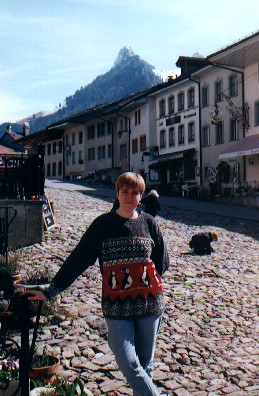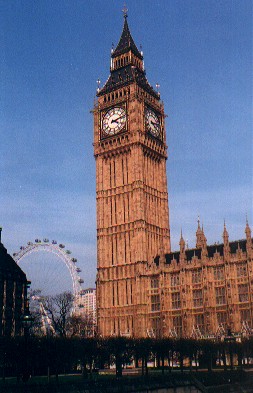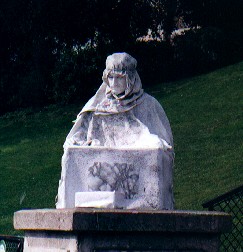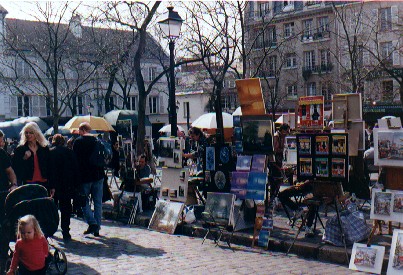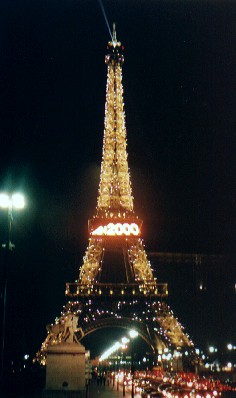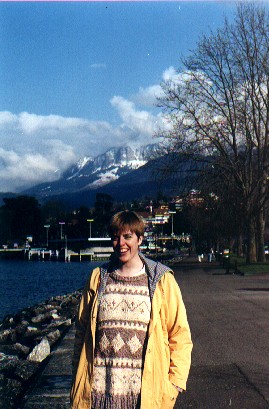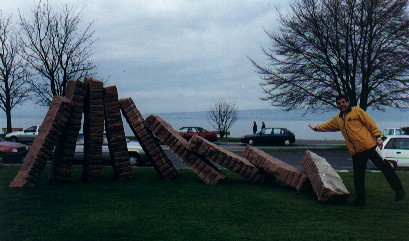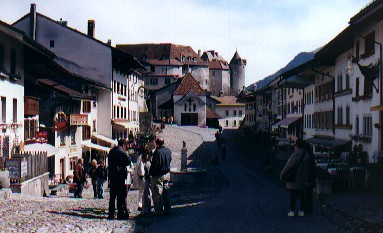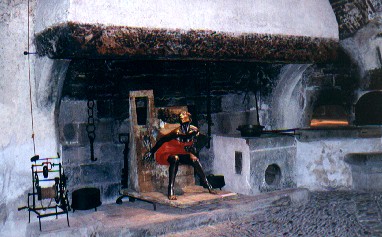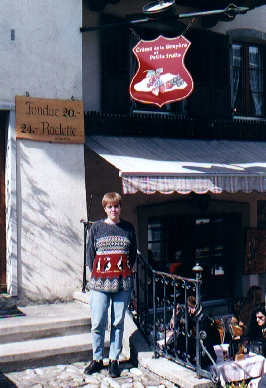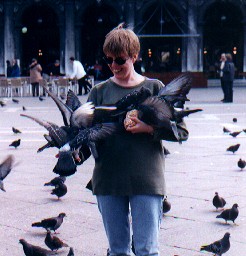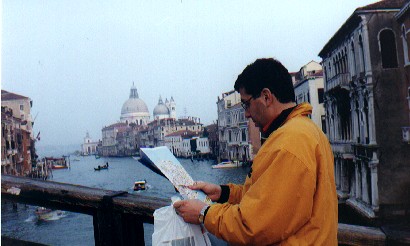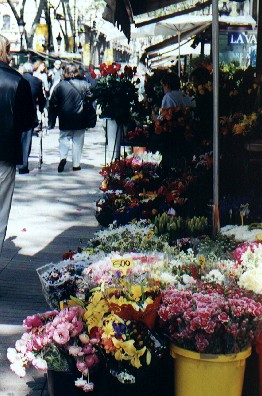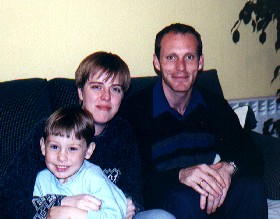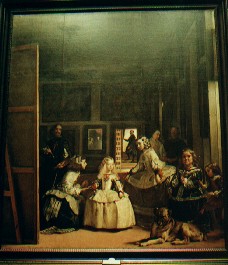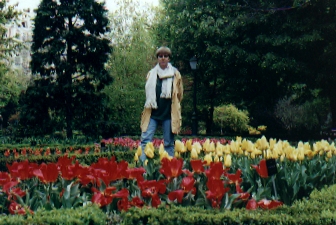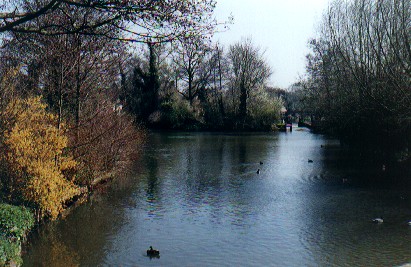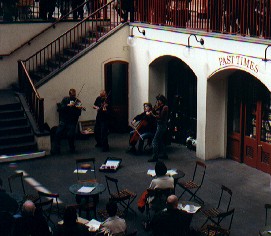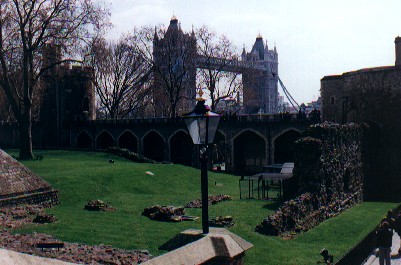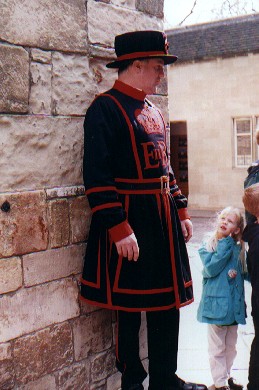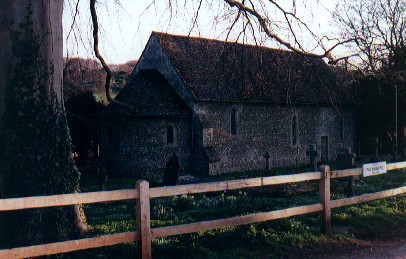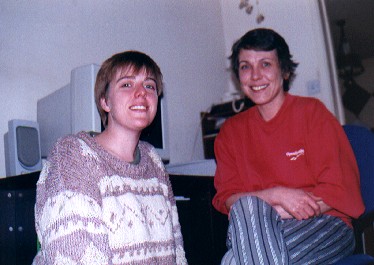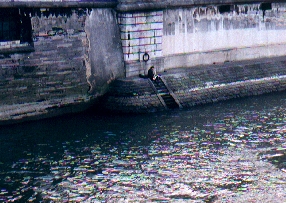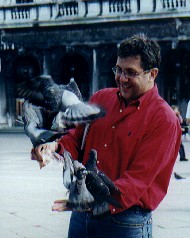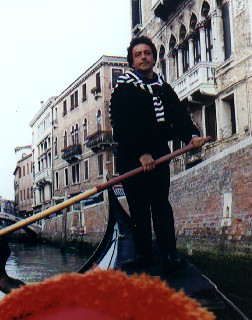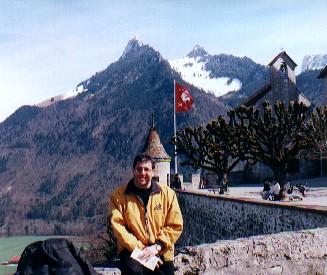
Touring EuropeCreated: 25 April 2000
Updated: 18 October 2000
In March / April 2000, I went on what will probably be my last big trip before getting a full time job somewhere (I hope) and settling down - it's been a great two years! One of the characteristics of this trip was the amount of planning I was able to do through the Internet. I bought return air tickets from Ireland to London through the Ryan Air website, bought a Europass and Eurostar rail tickets through the Europe by Eurail website, and even found an hotel in Paris through the Bookings website. And, of course, I looked up train timetables, found travel information, etc., all via this wonderful thing called the Internet. As usual, I have found the Lonely Planet travel guides to be immensely useful. I have listed the most useful websites, including all those I have just mentioned and links to the most relevant Lonely Planet publications, at the end of this travel report. Let me know if you find them useful.
On Tuesday, 21 March 2000 (having had just enough time to recover from my first St Patrick’s Day in Ireland), I flew from Dublin to London Gatwick airport. I was setting off on a three week tour of Europe which would include short stays in five countries: England, France, Switzerland, Italy and Spain.
London, EnglandI arrived in London at about 3:30 p.m., and headed straight for my hotel, which was within easy walking distance of Victoria Station. I stayed at the Romany House hotel, a very humble establishment which was nevertheless impeccably clean with a very friendly host. Accommodation in London is not cheap, and I was more than happy with my room, at less than £30 for the night.I was to leave early the next morning, and planned to make as much use of the few remaining hours of daylight as possible. I dropped my bags in my room and set out walking. It was late afternoon and most of the ‘attractions’ were closed for the day, but I enjoyed walking past Westminster Cathedral and Abbey, Big Ben and the Houses of Parliament, No. 10 Downing Street, and Buckingham Palace. I love water, and always like to touch the waters of oceans, lakes and rivers around the world - where that isn’t possible, I take great pleasure in crossing it, and it felt good to walk across the Thames. And Saint James Park is beautiful. But, most of all, I enjoyed just walking through the streets of London, watching people and looking in shop windows.
I am usually very hesitant to walk about alone at night. But, in my wanderings, I came across the Apollo Victoria Theatre, which was showing Andrew Lloyd Webber’s Starlight Express. It was less than five minutes walk away from the hotel, and I decided that the opportunity to see a good musical while in London was not to be missed. I spoiled myself with one of the best seats in the house, and had a wonderful time. Ignorant as I am, I didn’t know what to expect, and I must admit that the storyline (toy train engines racing and competing for the affections of the carriages) was more for children than for adults. But the music was lovely and the performances were good. Instead of a traditional stage-in-front-audience-facing-it layout, the theatre was made up of numerous ramps and courses circling the audience, and the entire performance took place on roller-blades! I was up early the next morning to take the Eurostar (the Channel train) from Waterloo station to Paris-Nord station, a three hour journey.
Paris, France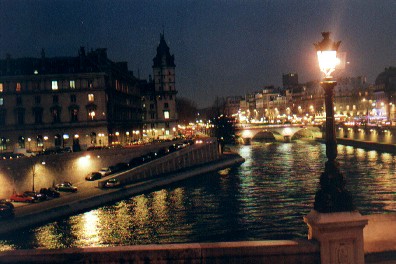 First thing I did on my arrival in Paris was to book my suitcase into the Left Luggage facility at the station. I was travelling light by many people’s standards - I only had a small, carry-on suitcase on wheels and a small daypack for a 24-day trip. But each was packed to capacity (mainly with Lonely Planet guidebooks), and I soon resolved to travel even lighter in future. I ventured, rather apprehensively, into the Paris Metro (underground train) system. I soon relaxed - while not the cleanest, this must be the most convenient, extensive, efficient and generally user-friendly underground system I have used – and I have used the undergrounds in eight countries! I soon arrived at the foot of the hill which makes up Montmartre.
Montmartre was lovely - topped by the Basilique du Sacré-Couer, it is an area of cafés, street artists and panoramic views of the city. In fact, on arriving at the Basilica, I was impressed with how clever one of the ‘living statues’ (street performers who mimic statues, only moving if someone places money in their collection plate) had been to stand on a pedestal opposite a real statue – when examining the ‘real’ statue more closely, I discovered that he, too, was a performer!
A visit to the Basilica is only an introduction to Montmartre. If you take the time to walk around a few corners, you will find yourself in a bustling square, filled with artists painting, selling their works, and soliciting the portrait-painting business.
And around another corner is a very special corner of Paris, the Espace Montmartre - Dalí, a small museum of Salvador Dalí’s works. I fell in love with one of his sculptures, Perfil du Temp, and coveted the original miniature for sale - a steal at 77 000 French Francs.
I returned to the station, picked up my suitcase, and set off in search of my hotel. I had booked it through the Internet, and had located the street on the map, but it took a fair amount of lugging my belongings up and down Metro stairs and through the streets of Paris to find it - the Hotel Atlantide Republique. Eventually I found myself in a pleasant, top-floor room. This hotel was another good choice: conveniently located and very reasonably priced (by European standards, that is - one could stay in a five star hotel for the same price, in South Africa). Hot and bothered, but not wanting to waste a moment, I took a quick shower and headed back into the streets. I walked to the Place de la Republique and then through the streets to the Centre Pompidou. Its magnificent post-modernist architecture had made a huge impression on me when I was learning about museum architecture for my diploma in Museology and, although I didn’t have time to go inside, I enjoyed sitting in the square and just looking at it for a while. And then, on to locate the Louvre (so as to save time the following morning) and see Pei’s famous pyramid, eat crepes and, of course, walk across the Seine. I knew that I wouldn’t have much time to see the sights and decided to join one of the night coach tours through the city, at 150 Francs (about US$25). The tour commentary (on audiotape) was exceedingly boring, but I did get to see Paris by night, drive up the Avenue de Champs Élysées, and see the Eiffel Tower, Notre Dame, the Hotel de Ville and other landmarks that I may have missed otherwise.
The next morning, I left the hotel early and went straight to the Louvre. What a museum! - it surely must be the most impressive art collection I have ever seen. I didn’t have time to see more than just a fraction of a fraction of the collection - but I did see the Mona Lisa, Venus de Milo and Michelangelo’s Slaves. I raced through room after room filled with sculptures and paintings – one would need at least a week to experience what the Louvre has to offer.
I spent a little time window shopping - I had picked up some nice items at a reasonable price on my earlier trip to Dunkirk, but everything in this part of Paris was way out of my price league. Then back to my hotel to once again pick up my suitcase and head for the station - a different station this time – and get on the train for Lausanne.
Lausanne and surroundings, SwitzerlandAlthough I spent eleven days in Lausanne, I didn’t do much in the way of tourism while I was there. Firstly, I had explored Lausanne and the surrounding area fairly extensively on my earlier trip to Switzerland. More importantly though, I had come to stay with my friend Roberto, who is undertaking an almost unbelievably intensive one year MBA program, and had promised to run quite a lot of errands for him while I was there. A typical day involved a late morning, followed by grocery shopping and a visit to the dry cleaners, a stroll around Ouchy, and some time spent using the free Internet access at IMD (where I did some much needed maintenance on this page). Later, Roberto would arrive home, we’d eat together, and he’d study until late in the night.
We had timed this visit well though - I arrived at End-of-Module time which meant that Roberto had a six-weekly luxury of (wait for it) a TWO AND A HALF DAY WEEKEND! (background noises of crowds cheering). And he had almost a day and a half free the next weekend, so we did manage to get out and about a bit. The first weekend we spent in Venice - more about that later. The next weekend, we crossed Lake Geneva to France to spend Saturday afternoon in Evian-les-Bain, of spring water fame, and then came home to have what must have been one of the most delicious meals of my life in a small waterfront restaurant called Le Café du Vieux Ouchy. There we had a starter of dry meat (as it is called there – in South Africa it is what we call chipped beef), pickled onions and gherkins, followed by the best fondue I have ever tasted. A local variation is to dip the crispy white bread into a spirit called kirsch. This was good, but I preferred it without. Accompanied by an excellent red wine and followed by strawberries in Gruyeres cream (a cream so thick that it is not necessary to whip it), it was a memorable meal.
The following day we took a train to Gruyeres itself. This is real Heidi country - the sun shining on beautiful green, rolling foothills, topped by towering snow-capped mountains. And in the heart of it all is the old town of Gruyeres - cobbled stone streets and old buildings, all surmounted by the Chateau de Gruyeres. As you may have already guessed, Gruyeres is dairy country, and is especially famous for its cheese, an essential ingredient of fondue, and its thick, rich cream. This is, indeed, a town for tourists. But I noticed something there that I have only seen once before, in a small town called San Pedro de Atacama in northern Chile. Although it is a tourist town, made up of restaurants and souvenir shops and museums, it still retains its own character and charm. Tourism didn’t detract from its appeal at all.
We got there at about midday, before most of the tourists arrived. We took a leisurely stroll through the town, stopping at the HR Giger Museum, devoted to the works and private collection of Giger, Oscar winner for special effects in the movie ALIEN. It was an interesting visit, and I know one or two of my friends who would have loved it, but it wasn’t really my thing – aliens and androids, many of them in S&M-like scenarios, etc. There were one or two very good fantasy pieces, though. We stopped at a good restaurant, Le Chalet, for lunch. What with us being in Gruyeres and having thoroughly enjoyed the meal the night before, we opted for almost exactly the same meal: fondue again, this time with a white wine. And it was excellent, although not quite as good as the one we had had in Lausanne. One notable improvement was the addition of baked new potatoes for dipping – mmmm just thinking about it now makes my mouth water. And then on to the Chateau de Gruyeres. This is a mediaeval castle, overlooking the valleys of Gruyeres, and being overlooked by its mountains. What were surprising were its exhibitions: along with period pieces and a Liszt piano, there was an exhibition of pieces by a contemporary sculptor (the name escapes me right now - I didn’t enjoy his work very much) spread throughout the castle. It was an interesting juxtaposition of the old and the new, and I am not completely sure of whether it fascinated me or made me unpleasantly uneasy. In one of the rooms was an excellent selection of contemporary artistic representations of Gruyeres and its chateau - one or two of which I would have loved to own.
Finally, back to a restaurant to sit on its terrace and eat strawberries with lashings of Gruyeres cream, and then a leisurely walk back to the station, a two hour trip back to Lausanne, and then I could relax while Roberto set to an hour or two of studying, poor lad.
To read about my first trip to Switzerland, enter here.Venice, Italy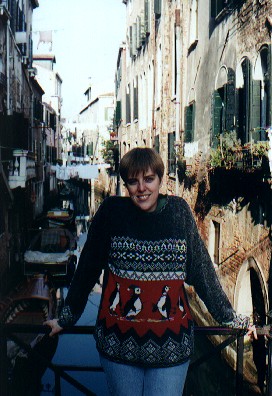 Venice was magical! I will gloss over the problems we had getting there - we set out without having booked a hotel, had to spend an unplanned night in Milan on the way, and later had a massive Italian rail strike to contend with. Nevertheless, we did manage to spend two days and one night (at the Hotel Paganelli, which I would recommend) in magical Venice. Surprisingly, there isn’t a lot to say about the weekend. The old island city of Venice, out in the Adriatic, is made up of majestic old buildings, seemingly jutting straight out of the canals which crisscross it. Their dilapidation somehow only adds to their charm. Hundreds of bridges, large and small, including the famous Bridge of Sighs (I remember asking triv questions about that bridge!), complete the experience.
The first place that everyone heads for has to be San Marco square - a huge square filled with hundreds, if not thousands, of pigeons. Two women sit with open vats of corn kernels, ladling them into plastic bags for tourists to buy and then feed the birds. The birds won’t touch you if you don’t have one of these magic packets in your hand - but the minute you buy one, before you even open it, they descend on you like something out of Alfred Hitchcock! The amazing thing is that they don’t go near the two corn-sellers.
The main thoroughfares of Venice are filled with tourists and flea markets, restaurants and upmarket boutiques. But the back streets, just a few minutes walk away, are almost deserted. It is possible to wander around a labyrinth of quiet paths, bridges and small plazas for hours - every now and then suddenly coming across one of Venice’s hundreds of churches, or breaking into a touristy area without warning and then, minutes later (after buying some ice-cream or fresh cut coconut), making one’s way back to the quieter back streets.
On our way back to the train on Sunday night (the strike had left us stranded, and we were forced to take an overnight train back so that Roberto could attend his classes on Monday morning), we discovered the old Jewish quarter of Venice. It was late and all the synagogues and the museum were closed, but it was lovely to walk through this area, which remains very Jewish in character. If I ever return to Venice, this will be one of the places I will be sure to visit.
Barcelona, SpainI had rather seriously underestimated the amount of time it would take me to travel from Lausanne to Madrid. I had thought I could hop on a train early in the morning and get there by evening, the same day. I was so very wrong - luckily, in fact, as this meant that I was forced to make an unplanned stop in Barcelona. I took an overnight train to Barcelona on Monday night, arrived early Tuesday morning, checked my luggage into the left luggage lockers, and prepared to spend a full day in the city before boarding another overnight train to Madrid in the evening.Some of you will know that there are many dialects spoken in Spain. The most important of these are Catalonian and Basque. I hadn't really thought too much about this, and when I heard the loudspeaker announcements on Barcelona station, I was dismayed at what I thought was proof of how much Spanish I had lost since my year in Chile. I could hardly understand a word! Fortunately, I soon remembered that Barcelona is in the Catalonian region and, although Catalonian is widely spoken, Castillian (which most of us think of as 'Spanish') is readily understood.
I spent a large part of the morning walking along La Rambla, Barcelona's most famous street. It stretches for a few kilometres from the port into the centre of town, and has a wide pedestrian thoroughfare. I had a surprisingly good egg and bacon breakfast at one of its many cafes and walked through the sections of the street devoted to flower markets, bird markets, etc. A number of museums and markets are situated on or near La Rambla, and there are many performance artists and buskers to be seen - all in all, it is possible to spend quite a few pleasant hours strolling along La Rambla.
I had never visited a wax museum before, and enjoyed stopping at the one near the port. And my visit to the museum of eroticism was certainly an interesting experience - sadomasochistic devices alongside some lovely Indian pillow books and Japanese figurines, nineteenth century English prints and 1940s pornography. It is a small collection with some nice pieces, but many of the items on display are sensationalist and, in my opinion, of dubious value. I do see the point of including modern porn, but I could not see why some of the very weak artworks on display were included. Barcelona has a large Gothic neighbourhood that borders on La Rambla - beautiful tall buildings and churches lining narrow streets, which open up into unexpected plazas. I started walking these streets during siesta time, and the cathedral and some of the museums I would have liked to have seen were closed. But it was a very pleasant walk. I found a wraparound skirt in a small shop, which I decided would make a very good souvenir of the visit, and headed on towards the Picasso museum. By the time I got there, I was pretty tired, and the sight of the queues and chaos outside the museum was enough to make me change my mind about visiting. Instead, I visited a small collection of Pre-Columbian artifacts in the Museu Barbier-Mueller Art Precolombi Barcelona nearby. Then on to walk in the park and have a drink of orange juice before heading for the Metro station and the Expiatory Temple of the Sagrada Familia (Sacred Family).
This is perhaps the only cathedral in the world today still being built...no, wait, that can't be true. Let me start again. In the Mediaeval and Renaissance periods, people would undertake building projects that could easily go on for centuries, knowing that neither they nor their children nor their grandchildren would ever see the end result. The temple of La Sagrada Familia is probably the only contemporary example of such a project. The brainchild of modernista architect Gaudi, it is still far from completion, long after his death. Although I am not a great fan of modernista architecture, the size of the ongoing project is awe inspiring, as is the height of the towering façades of the Nativity and the Passion! What is even more awe-inspiring is that these spires will eventually be dwarfed by the central façade, still to be built. You can enter the cathedral. Basically, you are entering a building site, noisy and dusty. There is also a museum in the crypt. Personally, I didn’t find that entering the site added much to the experience of just standing outside and staring up at the cathedral. But the entrance fee of 800 pesetas goes directly to the building fund, so it is all in a good cause :)
By the time I left the cathedral I was exhausted - but I still had a few hours to kill before it was time to head back to the station. So I took the Metro back to the port and walked along until I came to the Aquarium. It was pretty pricey, but as good a way as any (and better than most) to pass the time. And, after all, after spending all the money to get there, was I really going to begrudge spending 1450 pesetas to get in? (This was a question I asked myself many times - and one that will eventually get me into serious financial trouble, I expect, lol).
Madrid, SpainI arrived in Madrid early in the morning. I was pretty tired, having spent the night in a compartment with five teenage members of a touring sports group. Madrid has three train systems: the mainline long distance and international trains; the metro underground, and the Cercanías suburban trains. I arrived at Chamartin station, which connects all three systems, and transferred myself and my luggage from the mainline train to the Cercanías train, and headed off to meet Zhig.Zhigulii and I have been friends for almost three years. I met him in a Yahoo user-created chat room (which went by many names, all a variety of ‘Triv’). I spent a lot of time in that room for a period of about a year, and met a lot of friends, some of whom became very important to me. Zhig and I have kept in regular contact for all this time, through his move from the United States to Spain and my moves from South Africa to Chile and later to Ireland. One of the reasons I decided to include Spain in my itinerary was that I very much wanted to meet him ‘in real life’, and he and his wife were very kind to invite me to stay with them. I stayed in their home for two days, and had a great time. Gloria, particularly, was very good to me – even giving me a crash course in Fine Arts before I visited the Museo del Prado :) (despite my love for museums, my education in Fine Arts is sadly lacking). Meeting little Andrew was a great highlight. He is four and a half years old, and though he may not remember it, he used to talk with me through his daddy’s computer at the age of two. I had a WAV file of Andrew saying "Hello, Sally" as a startup sound for Windows, and many of the triviads saw photos of him and enjoyed his chicken imitations. After he overcame his initial shyness, he and I had a great time together. He took it on himself to teach me a little Spanish, and was a particularly hard taskmaster when it came to pronunciation. I have always had problems with the Spanish double r, and I pronounce the z in the Chilean, not the Spanish, manner - this was just not good enough, and he would make me repeat words over and over until he was satisfied, lol.
On my first day in Madrid I stopped at a taparía for a breakfast of Tortilla Espanola, before visiting the Museo del Prado and the Museo Nacional Centro de Arte Reina Sofia, two of Madrid’s three exceptional art museums. Once again, I was struck by the sheer quantity of excellent artworks - and once again, I regretted my very poor knowledge of art history. I have been immensely lucky in that my travels and my interest in museums have brought me into contact with some of the world's artistic masterpieces (and I use the word "artistic" in its broadest sense!). In Madrid, I was privileged to see Picasso's Guernica, Velazquez' Las Menina's, and hundreds of other works by, amongst others, Goya and El Greco.
I also walked through the botanical gardens, explored the streets and shops, walked past the Palacio Real, had a really excellent Mexican meal at the Taqueria de Birra at Plaza de las Comendadoras, near Metro station Novicidado, and spent 45 minutes catching up with my e-mail in a nearby internet café.
Although I spent most of my second day in Madrid with Zhig’s family, I did spend part of the morning at the very good Museo Arqueológico Nacional. I decided to walk back to the Cercanía station through the Parque del Buen Retiro. This is a very beautiful park, with a central lake and a wide promenade, frequented by musicians and buskers of every description. My personal favourite was the Michael Jackson Man. That night I climbed into yet another overnight train - by this time I was getting heartily sick of sleeping on trains (third night out of four!).
Paris, FranceI arrived in Paris-Austerlitz station at about 8 a.m., and aimed to be at the Nord station at about 12 noon to safely catch the 1 p.m. Eurostar train to London. This meant that, after checking my luggage into the Left Luggage lockers and finding a bathroom, I had about three hours to wander around Paris. Although I had enjoyed many aspects of Paris when I stayed overnight two weeks earlier, I hadn’t found it to be the enchanting experience I had been expecting. Maybe it was because I wasn’t with a lover ;), or maybe it was just that I tried to do and see too much in too short a time. On this calm and peaceful Friday morning, though, with no definite plans, I did feel a little of the enchantment of Paris.I walked through the Botanical Gardens to the Institut Musulman et Mosquee. I wanted to visit the mosque. Also, I had read that there was a hammam there and, after my experiences in Tunisia, I was very keen to try it out (especially after a night on the train!). I found the Institut easily enough - together with the hammam and what looked to be a very good restaurant with some delicious sounding couscous meals on the menu outside. Unfortunately, I would have had to wait half an hour before it would open. A ‘package deal’ was advertised outside – mint tea and entrance to the hammam, with massage, followed by a good meal, all for 300 Francs. I was tempted, and if I had been either short of time or short of money I may well have stayed. But, being short of both, I decided to resist the temptation. I walked up to the Seine and literally gasped with pleasure when I caught my first, unexpected, glimpse of the Notre Dame cathedral. I had seen the cathedral, from the front and at night, during the rather boring city tour I had taken on my first night in Paris, and I had thought it a beautifully symetrical building. But its sheer loveliness had escaped me until I saw it that morning in Paris.
After visiting the cathedral and seeing Sante-Chapelle (from the outside - by that stage it was a choice of the chapel or breakfast, unless I wanted to draw more Francs - I know, I know, I missed the stained glass windows), I crossed the bridge, had crepes for breakfast and walked to the Hotel de Ville. Then a stroll back to the Ile de la Cite, crossing over to the Ile St-Louis, and a leisurely walk along the banks of the Seine in a delightful park, filled with lawns and trees, sculptures, skateboarders and joggers, back to the station.
Colchester and surroundings, England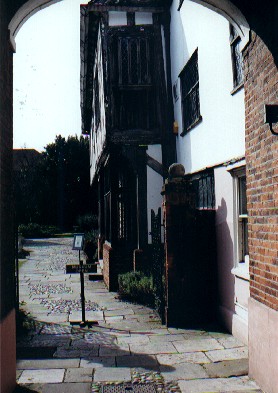 By the time I arrived in England, I was exhausted. I was sick of trains, and tired of carrying my suitcase around. I arrived in Waterloo Station, went up and down a few flights of stairs, caught the tube to Embankment Station, went up and down a few more flights of stairs, caught the tube to Liverpool Street Station, went up and down a few more flights of stairs, and caught the train to Colchester, where I was to meet Tony and Riet. These friends of mine, whom I had met in Tunisia, lived in a nearby village. I was to phone from Liverpool Street Station, but I only had a few minutes to catch the last cheap train to Colchester and the very helpful man in the ticket office assured me that there were phones on the train. So I ran to catch the train, heaved my suitcase inside, and set off in search of the phone. May I add, at this point, that I was hugely impressed? We just don’t have phones on trains in South Africa! On finding the phone, though, I found that it would only accept phone cards or credit cards. I can’t believe that I used an international credit card transaction to make a local call! And, to top it all off, I got through to Riet but she couldn’t hear me. I gave up, found a seat on the crowded train, and worried all the way to Colchester. I needn’t have worried. When I arrived in Colchester and called Tony, he told me that Riet had realised it was me and was on her way to pick me up. I was to stay with Tony and Riet for three days, and they spoiled me immensely. I soon abandoned my plans for commuting to London and intensive sightseeing. I had just done too much of that in the preceding two and a half weeks. Instead, my hosts allowed me to dip briefly into English village life.
During the weekend, I was taken along to an evening spent at the village social club; a morning’s sightseeing in Colchester (I recommend the Colchester Castle museum - it is very good, but unfortunately has no website); a 60th birthday party and an early morning bicycle race (Tony took part and Riet was an official timekeeper - I just lounged around and watched). I also enjoyed many hours of fine conversation, including going through travel photographs for their trips to China, Bali and Tunisia. A high point was sitting with Tony, his maps and his photographs, retracing his steps on his recent hike to the Everest base camp.
Another high point was being introduced to Constable country - the settings of many of the famous painter’s artworks and a gentle two mile walk to Dedham, followed by a drink in an old English pub. On the Monday morning, I left their delicious meals and comfortable bed, packed all my freshly cleaned clothes, picked up my suitcase, and headed for London.
London, EnglandAfter leaving my luggage at Paddington Station, I headed for the British Museum - an almost legendary name in the museum world. This huge, huge, huge (can’t think of another adjective here) museum was nothing like what I had been expecting. If you asked me, now, exactly what I had actually been expecting, I wouldn’t know how to answer you. I’d say: "something more majestic" - but how could those cavernous halls filled with the world’s treasures not be considered majestic? I’d say: "something more awe-inspiring" - but, again, who wouldn’t be inspired with awe when faced with treasures before only read about. I was hugely impressed with the objects in the museum - but something was missing!
Standing in front of the Rosetta stone was certainly a moment to remember. I remember learning about the Rosetta stone in junior school, and being fascinated by the concept of a single object unlocking the secrets of an entire written language. As in almost all my museum visits on this trip, I was pushed for time. A couple of hours allowed me to see the Rosetta stone, the Elgin marbles, the Egyptian mummies, a pair of ancient Assyrian winged bulls, a beautiful old Qu’ran, and many other treasures. As well as having the most common 'must-sees' on my wish-list, there were two objects that I wanted to see, very badly indeed. One was the massive moai plundered from the ceremonial village of Orongo on Easter Island, the other was the inscription stone from the Punic tower near Dougga, in Tunisia. This tower stood for nearly 2100 years, until the removal of the inscription stone by the British caused it to collapse. Sadly, the magnificent British Museum collection has been built up through the centuries largely through colonial pillage. Sadly, too, neither of these pieces is on display in the British Museum. The moai, while part of the collection of the British Museum, has until recently been displayed in the Museum of Mankind, but is shortly to be moved to the British Museum. The Punic inscription stone is not on display, although it is apparently possible to arrange a private viewing.
After my visit to the museum, I walked to Covent Garden. This doesn’t look anything like the scenes from My Fair Lady - it is now a shopping mall for speciality shops and restaurants. And very pleasant it is, too. I only spent about twenty minutes there. While wandering around, I heard beautiful music. For an optional few coins in a hat, I could listen to an excellent young string quartet named Sigma performing Mozart, complete with foot stamping!
And then on to the Tower of London. The tower is not cheap, but it is well worth the entrance fee. Once inside, you can tour a number of buildings, see the Crown Jewels, visit a whole lot of exhibitions and, best of all, take part in a variety of entertaining Beefeaters’ tours - all for free.
I remember, when I was quite a little girl, my mother returning from a trip to England with a rather unusual ‘souvenir’ – a few squares of toilet paper from the Tower of London! She thought that they couldn’t want people to use very much of it - it was almost as stiff as a board, and an emery board at that, as it was so abrasive. She brought it back to show us because, as she said, it had to be seen (and felt!) to be believed. I made my own personal pilgrimage to the loos, but was somewhat disappointed to find completely normal loo paper, lol.
Then, back to the station and on to Oxfordshire.
Oxfordshire and surroundings, EnglandMy last stop was in Oxfordshire. I stayed in a small village called Ewelme, in what must be one of the most beautiful corners of England. This tiny village had one shop/post office, one pub, the natural pool where Henry VIII used to take Anne Boleyn swimming, an eleventh century Crusader church, and a host of interesting characters.
My friend Shauna’s uncle lives in the cloisters of an old church. The old monks cells have been converted into an almshouse, with one being set aside as a guestroom, and this is where I stayed.
He was very good to me while I was there - ferrying me to the nearest town, from where I could take a bus into Oxford itself, even at the most unearthly hours of the morning. Unfortunately, I had only two full days in the area. I spent one of these days in Oxford itself. While we had been living in Chile, Roberto was applying to a number of business schools in Europe. The Said Business School at Oxford University was one of these, and so there was a time where spending a year living in Oxford was a very real possibility for me. This added a new perspective to my wanderings through the town. Oxford is lovely - the old colleges are beautiful, and I wish I had had time to wander around inside the college walls. As it was, I toured the city with the GuideFriday bus, visited Alice’s shop (the Old Sheep Shop from Through the Looking Glass fame), and visited an exhibition on, of all things, South Africa’s political struggles in the Old Bodleian Library. Of course, there is also The Oxford Story – a multi-media presentation into the history of Oxford. This is something of a theme-park experience – one travels through the displays while sitting in an old school desk! I also saw another Bridge of Sighs - Oxford’s Venetian bridge, named after the evocatively beautiful bridge through which I had walked, in Venice, just a week earlier. Then back to Ewelme, and an excellent dinner in the local pub, the Shepherd’s Hut. The food was a far cry from pub-food, but the ‘entertainment’ was the ubiquitous pub quiz, lol.
My last full day in England dawned, and I had a busy schedule ahead of me. I wanted to meet Kazzy, an old Internet chat friend who lives nearby. I planned to see her en-route to fulfill a childhood ambition - to see Stonehenge. I have been fascinated with Stonehenge since - well, for as long as I can remember, really. After a lift into Wallingford, I caught the morning’s first bus to Oxford, and then I caught the first bus to Kazzy’s town (that has a ring to it, doesn’t it Kazzy? Maybe we should submit it as a new name!). The hour and a half I spent with her just flew by, but I had to get going if I wanted to see Stonehenge.
If you want to use public transport to see Stonehenge, just about the only option is to go from Salisbury by bus. Two buses took me to Salisbury. By this time I was feeling pretty grotty - I suffer from motion sickness, which had been aggravated by the fact that I had been reading about Salisbury in the bus. There is a lot to see in Salisbury – notably the cathedral – and I was hoping to fit in a bit of local sightseeing around my trip to Stonehenge. I was to be bitterly disappointed!
On arriving at the Salisbury bus depot, at about 2:20 pm, I went to the information office to check at what time the next bus would be leaving. Imagine my disappointment when I was told that the last bus had left at 2 pm! There was another option - a bus to a nearby village and a two-mile hike (in the rain, I might add) to Stonehenge. Or there was an off chance that I could get a taxi. I was about to take this option when I decided to check on bus times back to Oxford. I soon saw that there was no way I could go to Stonehenge and catch the last bus back towards Oxford – I would have to leave almost immediately. I was horrified, on double checking, that even if I left by the next bus, I would miss the last connection back into Oxford! Now I began to panic. In any other circumstances, I would have decided to stay overnight in Salisbury, see a bit of the town in the afternoon and Stonehenge in the morning and return to Oxford on the following day. But my plane to Dublin was leaving from London at 10 o’clock in the morning – an inconvenient schedule which was already making it necessary for my poor host to drive me into Oxford at 5 a.m. I rushed to the train station and found that I could take a £17 train (compare this to the less than £10 which I would have spent for the entire day’s bus travel - most of which I had already spent) which would get me into Oxford in time to catch the last bus back to Ewelme. I was devastated, but there was nothing for it - back to Oxford I went, and returned to Dublin in the morning. To read about my second trip to England, enter here.High Points
Low Points
Useful Links:Transport / Tickets / Fares / TimetablesEurope by Eurail and Britain by BritrailI found it difficult to get the tickets and passes from Ireland - in fact, I found it cheaper and quicker to get all the information I needed and buy the tickets from these American-run sites. I bought my Europass, Eurostar tickets and British Heritage Pass through them. (Note, though, that one can get an English Heritage pass at certain sites within England, which is significantly better value-for-money. I discovered this during my second visit to England.)
The Oxford Tube
CityLink
City Coach ToursCityrama Paris ToursI went on the Paris night tour - to be honest, it wasn't hugely interesting or well-presented, and it was expensive at 150 Francs, but I did get to see Paris by Night, and a lot of sights that I wouldn't have seen otherwise (I spent less than 24 hours in Paris).
GuideFriday
AccomodationRomany House Hotel(e-mail link) 35 Longmoore Street, London (near Victoria Station) Tel 0207 8345553; Fax: 0207 8340495
BOOKINGS Online Hotel Reservation System
Hotel Paganelli
MuseumsLondon, England
Paris, France
The Louvre
Gruyeres, Switzerland
Museum HR Giger
Chateau de Gruyeres
Venice, Italy A list of Venetian art, churches and museums
Barcelona and Madrid, Spain Museo Nacional Centro de Arte Reina Sofia, Madrid
Useful Books from Amazon.com:
Quick travel: 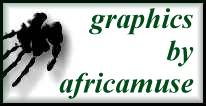
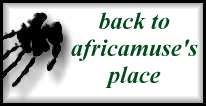
all original material (text, graphics, photographs and programming) © 2000 Sally Smith http://geocities.datacellar.net/africamuse
|
